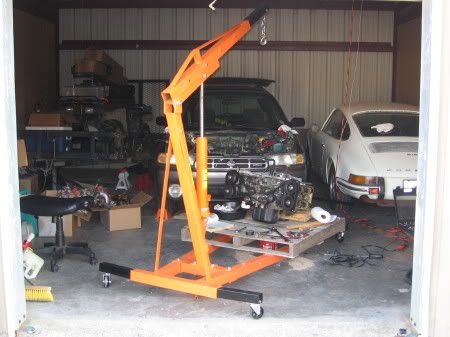Back to Business
Now it's time to stop for a moment getting my Robert Pirsig on, cut with the chautauqua crap and talk about the latest work I've done on the Ghia.
Last night I got my new parts order in from Cip1: a pair of valve cover gaskets, a new distributor clamp, new spark plug wires and an electronic ignition. I have yet to adjust the valves in the Ghia, but they're due for it as the last time was in October when Quality Coaches did it. Apparently they should be adjusted every time the oil is changed, but there's some disagreement among the VW community about that. Most do agree, though, that they need to be at least checked every 3,000 miles for proper clearance.
The original distributor clamp I had was actually bent out of shape, making it difficult to get a socket over the nut to tighten and loosen it and then making it impossible to tighten the distributor down sufficiently. My timing would be way too retarded, about 15* ATDC within only 100 miles or so. A new clamp was only $2.50, although you can get a billet clamp for $15 that isn't as prone to bending out of shape. I'll see how the stock chrome clamp checks out over time, though.
I have yet to install the new plugs. They're stock except for the pretty, yellow color. My current ones are probably OK but they just look old and at least one of them has a cracked boot where it attaches to the distributor. I've got the black tape solution around that boot for now but knew I needed new plugs ever since I did that. Only $10.
Of course, the real jewel of the parts order was my electronic ignition. You can really go all-out and get a high-capacity coil, electronic ignition, expensive wires and plugs and spend $150 or so. But, I went with the most basic replacement for my points and condenser for $40. The traditional point breaker/condenser system is electrical, so at first I wasn't sure what people meant by saying they upgraded to electronic ignition and why it was so great.
Basically, point breakers are just two little connectors that open and close as the distributor cam pushes on the arm. This triggers the coil to send a jolt to the distributor every time the rotor points to a new cylinder. The real problem with this system is the distributor cam rubbing against the point breaker arm. All that rubbing over time wears things out and you have to constantly re-adjust your point gap to get a good spark.
I'd been doing that and even purchased new points for only $3 but then noticed that when I reved the motor my dwell angle went from a good 44* to about 39-38*. That meant the point gap was expanding when I reved which meant the distributor shaft was a little worn and creating an erratic point gap. One solution would be to rebuild the distributor, get new bushings and all that and then you'd get a steadier point gap.
But, for a few extra bucks I was able to skip an all-out distributor rebuild and basically never have to worry about points again. It's pretty slick how it works. Instead of a condenser attached to the outside of the distributor you've got a sensor on the inside doing the condensing and sending the signal to the coil. Over that sensor you put this disc with 4 magnets on it. The sensor is triggered by the magnets as they rotate around the distributor.
So, it works more-or-less just like a modern bicycle speedometer which has a magnet you attach to the spokes and a sensor you attach to the fork. When I put the strobe on the pulley to time it I was amazed at how rock-steady the timing mark was compared to before. I never thought it wasn't steady before, but now I see that it was jumping around by .5* here and there. The little white notch on the front of the pulley used to appear blurry under the strobe but now it looks like the pulley's not even moving.
That is, I was able to time it once I got unconfused by the difference between the #1 and #15 ports on the coil. The old condenser had one wire connecting it to the #1 port but nothing else connected to the coil. The new sensor had two wires: red to #15 and black to #1. I had them flipped at first and the motor would not start. I could tell right away something was wrong because I didn't even hear a slight sputter meaning a spark actually happened and ignited a fuel/air mixture. So, I verified the ports, flipped them around and got better results. I did have to do a hit-and-miss job of getting the timing close at first to get the motor started.
I drove it around last night and didn't notice any difference in performance and that's expected. The real benefit can be a 10-15% increase in MPG, though, and longer spark plug life. Overall, just a more dependable system. I'm off now to finally replace the wires.


